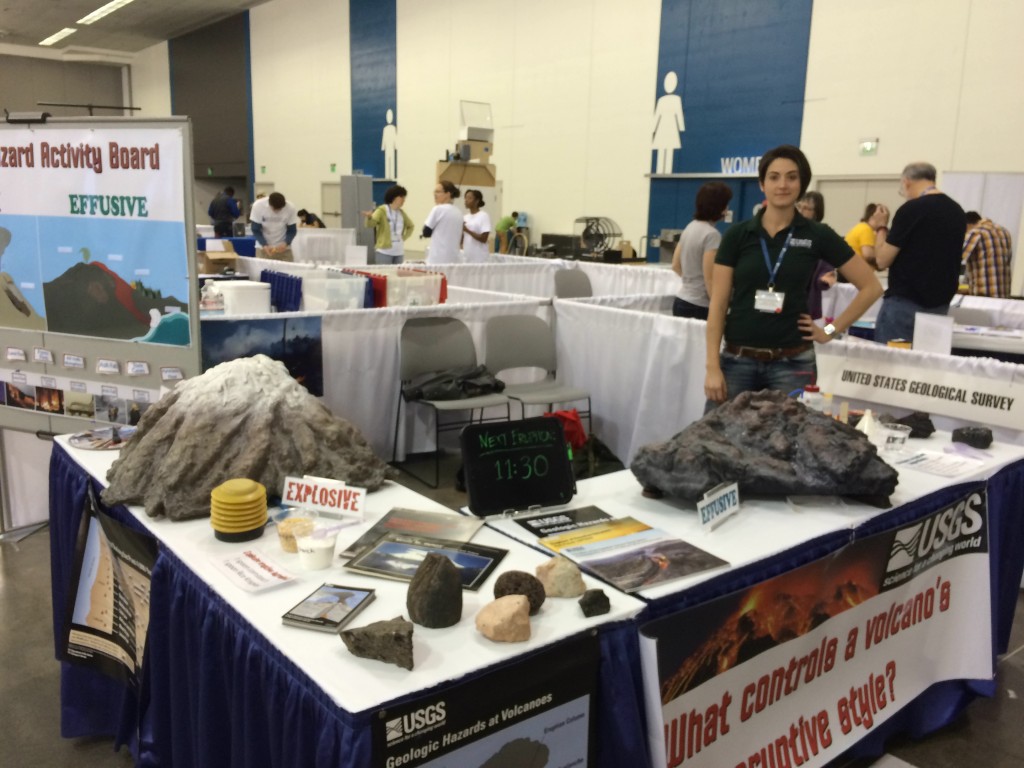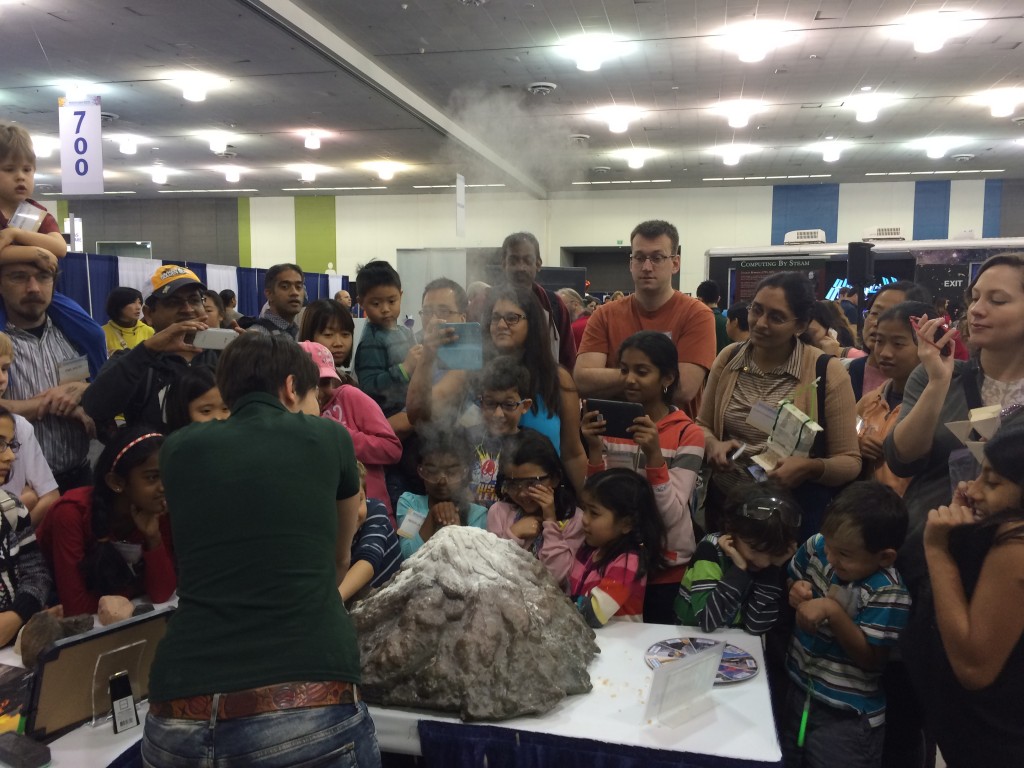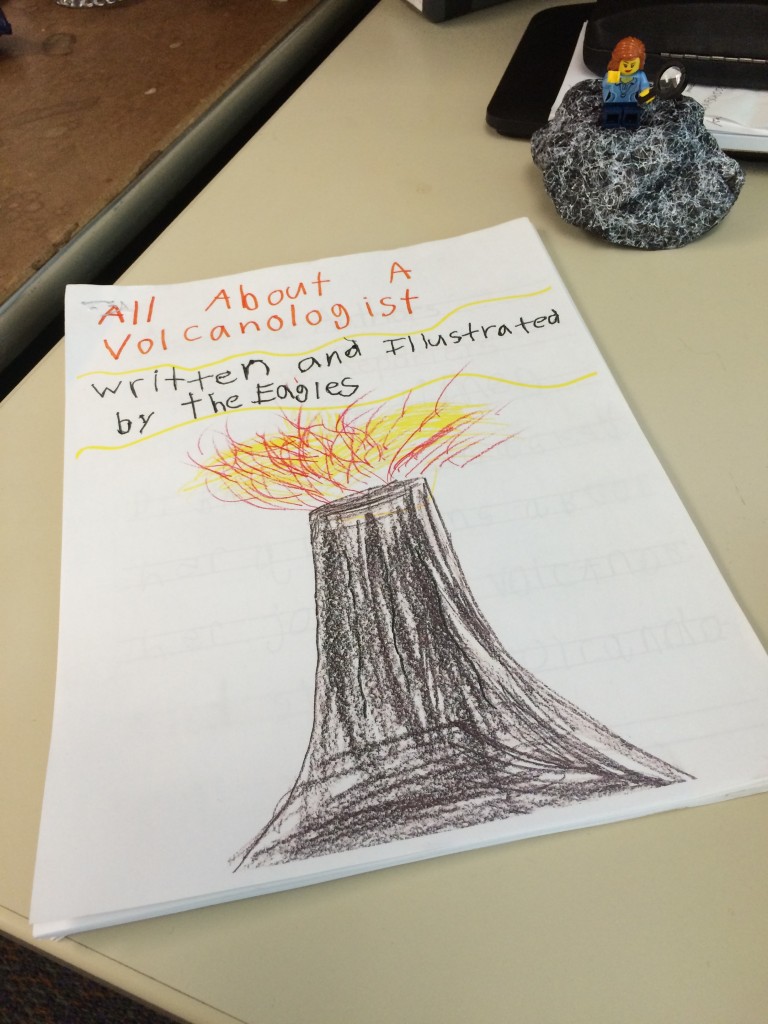27 April 2015
Things you learn doing outreach
Posted by Jessica Ball
Note: I scheduled this post last week, so it will probably seem a little frivolous given recent geologic events in Nepal and Chile. There are a couple of other geobloggers covering those in much more depth than I could attempt at the moment – check out The Landslide Blog by Dave Petley and the USGS earthquake page for Nepal information and the Eruptions blog by Erik Klemetti and Janine Krippner’s Twitter feed for updates on the Calbuco eruption.

The USGS demo table at AAAS’s Family Science Days, back in February (volcanologist Kayla Iacovino for scale)
A short, light post this time. I’ll be doing an outreach event as a USGS rep in a couple of weeks, and having done the demo once already at AAAS’s 2015 Family Science Days, I was thinking about the things I learned last time. Some of these have also applied to other outreach I’ve done (I love doing video chats with students and science clubs, especially if I can get people excited about geology!)
- Volcanoes are big draws, especially when you can make them explode.

Kayla (@kaylai) setting off our explosive eruption at AAAS’s annual meeting open house in February.
- Hand sanitizer is an important component of your demo kit. (I spent the week after AAAS flat on my back with a virus from one of the children who coughed, sneezed and then put their hands all over the demo materials. Kids, I love you, but I really don’t love your germs. Parents, if your kid is getting over some kind of bug and you’re not going to keep them from doing this kind of thing, please don’t bring them to a big public event. Believe me, your friendly neighborhood volcanologist will thank you.)
- The ASL sign for volcano is very neat. It also makes me want to learn more geology-related ASL, because I felt really bad when I wasn’t sure if the deaf students who came by our table could read lips.
- A higher proportion of dish soap in your baking-soda-and-vinegar eruption makes for more exciting lava flows.
- The younger kids are, the more profound their questions will be. It’s always the youngest students who ask questions like “why do volcanoes erupt” that necessitate in-depth discussions of mantle dynamics, plate tectonic boundaries and gas exsolution.
- Interacting personally is a lot more rewarding (on both sides) than those “interview-a-scientist-for-this-report” type assignments that you often see kids coming home with. As described here, those sorts of things are really superficial and don’t have much benefit for either side. Obviously it’s not possible to arrange a personal visit or a field trip or a face-to-face interview all the time, but they’re waaay better for both parties.
- Outreach can be exhausting, but really rewarding (especially if your audience thanks you by writing a book about you):

A fantastic thank-you from a class I did a video chat with earlier this year. (Starring moi!) Lego scientist for scale.
What are some of your favorite outreach lessons and stories?



 Jessica Ball is a volcanologist at the U.S. Geological Survey, researching volcanic hydrothermal systems and stability, and doing science communication for the California Volcano Observatory. She previously worked at the Geological Society of America's Washington DC Policy Office, learning about the intersection of Earth science and legislative affairs. Her Mendenhall postdoc and PhD focused on how water affects the stability of volcanoes, and involved both field investigations and numerical modeling applications. Her blogging covers a range of topics, from her experiences in academic geosciences to science outreach and communication to her field and lab work in volcanology.
Jessica Ball is a volcanologist at the U.S. Geological Survey, researching volcanic hydrothermal systems and stability, and doing science communication for the California Volcano Observatory. She previously worked at the Geological Society of America's Washington DC Policy Office, learning about the intersection of Earth science and legislative affairs. Her Mendenhall postdoc and PhD focused on how water affects the stability of volcanoes, and involved both field investigations and numerical modeling applications. Her blogging covers a range of topics, from her experiences in academic geosciences to science outreach and communication to her field and lab work in volcanology.